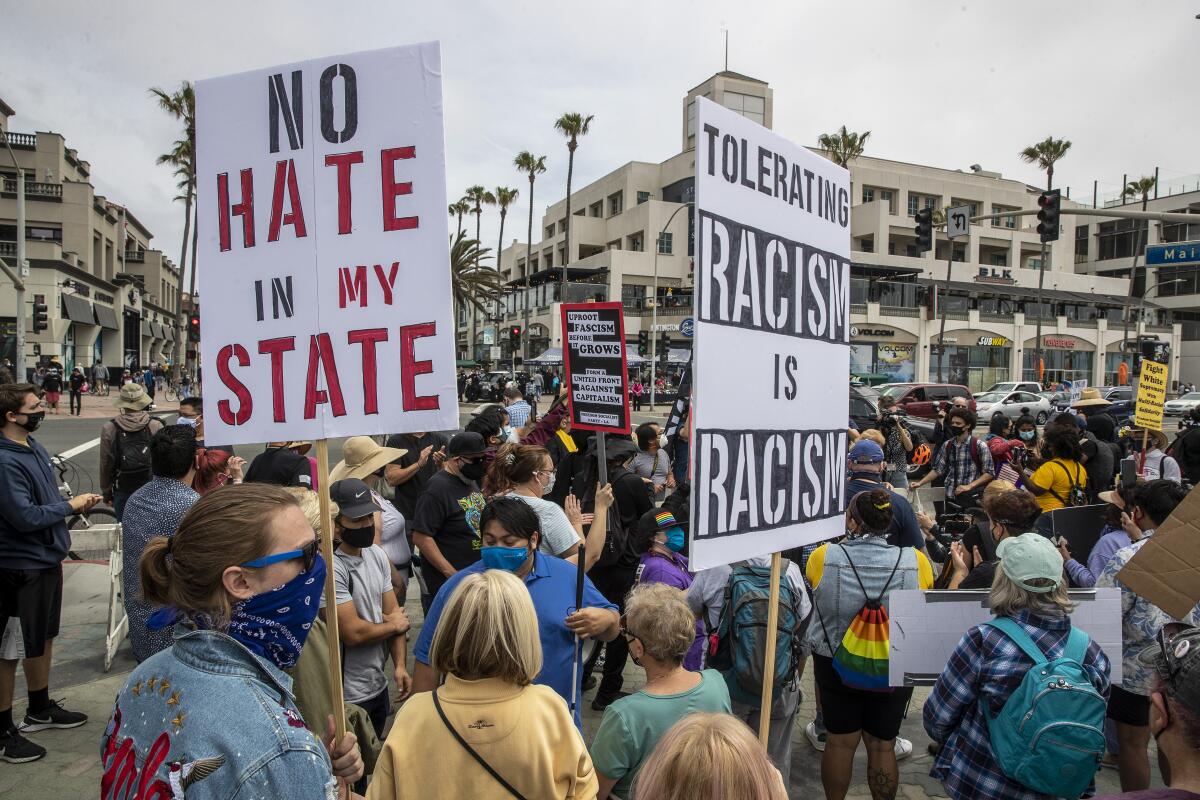Apodaca: Though many of its residents are peaceful, Orange County hasn’t avoided an upward trend of hate

- Share via
Orange County, we have a problem.
The problem is hate, and it won’t do for us to ignore, excuse, downplay or deny it. It’s real, it’s destructive, and it’s not just relegated to isolated events, for it is woven into the fabric of many of our communities.
The trend is worrying. According to reports by agencies and organizations that track such data, the number of hate-related incidents has been on the rise.
Indeed, for years now we’ve seen a steady increase in hate-related activity. The Anti-Defamation League found 49 hate-inspired incidents in the county in 2020. And those are just the ones that were reported; the actual number is likely much higher.
According to the Orange County Human Relations Commission’s annual Hate Crime Report released last fall, the number of crimes and incidents rose for five consecutive years. It found that in just one year, from 2018 to 2019, hate crime surged 24 percent.
I doubt the reports for this year will show any abatement, for in the past month alone the local news has been filled with disturbing stories of verbal and physical assaults on residents of Asian descent; an attack on a transgender woman; the distribution of Ku Klux Klan fliers to homes in Newport Beach and Huntington Beach and plans for a “White Lives Matter” rally in Huntington Beach.
Two important caveats:
First, it’s not just Orange County. The ominous upward trajectory of hate activity is occurring nationwide.
The ADL’s Center on Extremism, for example, tracked a near-doubling last year of white supremacist propaganda efforts, including the distribution of racist, anti-Semitic and anti-LGBTQ materials. The 5,125 reported cases represented the highest number recorded by the anti-hate organization.
For all his warnings, Dr. Andrew Noymer wasn’t pessimistic enough about the COVID-19 death toll in Orange County.
The scope of the problem is so massive that the Department of Homeland Security now considers domestic white supremacist violence to be the most lethal overall threat facing the United States.
Second, it should also be acknowledged that the majority of Orange County residents undoubtedly are peaceful, tolerant, compassionate people who simply want to live in harmony with their neighbors regardless of their differences. This is a beautiful place to live most of the time, and that is something to be celebrated.
But it can hardly be a coincidence that these hate-fueled incidents are occurring more frequently here at the same time that we are experiencing significant demographic change and moving toward a more racially and ethnically diverse populous.
The county has made great strides toward shaking the dark shadow of a notorious past known for KKK street patrols, allegiance to the John Birch Society, skinheads and policies intended to exclude anyone deemed to be an outsider.
Now we are subjected to a backlash by forces of intolerance that seek to undermine the progress that has been made in fostering a more inclusive society.
In confronting this reality we must recognize that — while understanding that there’s nothing new about hate and bigotry — there has been a big change in the methods that hate groups use to recruit, organize and incite.
In the old days, hate organizations like the KKK recruited on the local level and often held meetings in places like garages, basements and woods, said Rabbi Peter Levi, the Orange County regional director for the ADL.
But since the advent of smart phones, hate groups have grown more adept and aggressive in utilizing the internet and social media to organize, identify potential followers and spread propaganda, often lacing their white supremacist ideology with coded, patriotic-sounding rhetoric. Even as much of this activity has been banned from mainstream platforms, it has proliferated on alternative sites.
“With the internet and social media, any seventh-grader on an iPhone using their parents’ Wi-Fi in the middle of the night can find a hate group,” Levi said. “And that’s what’s happening.”
There have been alarming reports recently of extremist groups using video games to recruit and radicalize youth, luring in children as young as seven with appealing graphics and characters — all while promoting racial tropes and disinformation.
A concurrent trend is harder to define or quantify; nonetheless, it’s impossible to ignore. We find ourselves in an era when hate groups feel they have license to be louder and more brazen.
Those who espouse racist, anti-Semitic, anti-LGBTQ and other bigoted ideology are not hiding under rocks. They are dropping banners over the 405 Freeway, distributing leaflets on college campuses and running for public office. They are emboldened, and they are working hard to normalize their toxic way of thinking.
Though it’s tempting to try to tune these voices out — why should we help amplify their messages of hate and intolerance? — we do so at great risk.
As Levi explained, “Paying attention to it and addressing it isn’t the same as giving the haters and extremists a megaphone.”
So what do we do? Do we need to understand hate — where it comes from and why some people are more susceptible to it — in order to deal with it? How do we stamp it out? Is that even possible?
I’ll attempt to find some answers for my next column.
All the latest on Orange County from Orange County.
Get our free TimesOC newsletter.
You may occasionally receive promotional content from the Daily Pilot.





